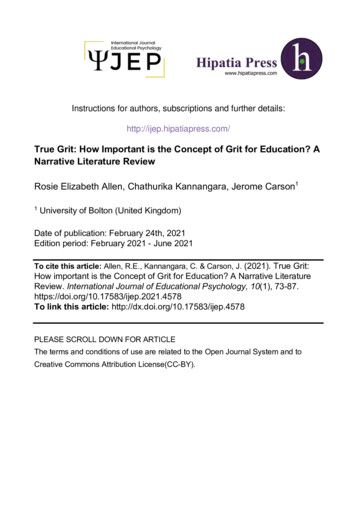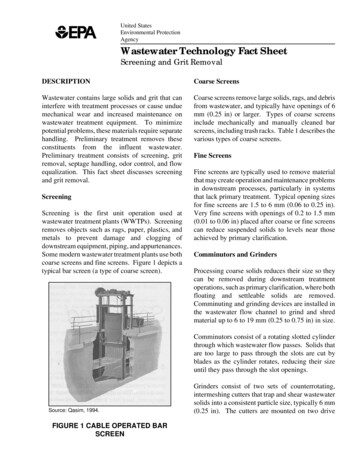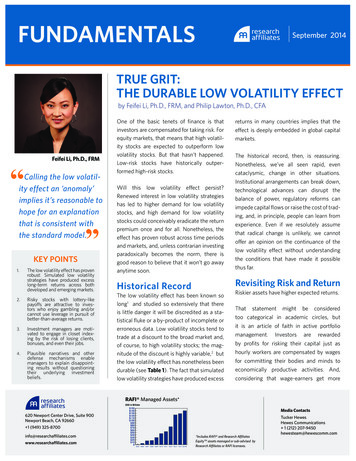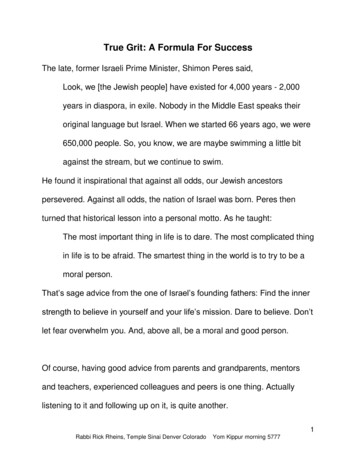
Transcription
True Grit? Making a Scientific Object and Pedagogical ToolChristopher KirchgaslerThe University of KansasAbstract: The educability of personal qualities has garnered attention for its potential to raisestudent achievement. This investigation asks how one such quality—grit—has become acommonsensical way to think about differences among students. As a history of the present, gritis approached as a cultural thesis that links individualism to narratives of Americanexceptionalism and historical progress. This thesis is embodied in contemporary school reformsto “get gritty” in order to close achievement gaps. A danger of these reforms is how pedagogiesof grit generate classificatory regimes that divide people by the display of particular attitudesand behaviors. As grit travels globally, it decontextualizes social and economic inequalities, andexplains them as owing to the intrinsic qualities of people.A fundamental question asked of modern schooling has been why some children succeed whileothers fail. In recent years, psychologists, economists, and educators have posed answers thatseek to go beyond the cognitive dimensions traditionally associated with IQ and achievementtesting. Where once the mind’s traits were given as fixed and immutable, psychologists todayhave argued for the need to view human capabilities as more expansive and flexible than that.Recent research, for instance, argues that a “growth mindset” can unlock and transform one’sinner abilities (Dweck, 2006). Research on growth mindset dovetails with the burgeoning field ofpositive psychology, which proposes the study of “positive subjective experiences,” “individualtraits,” and “the institutions that enable them” in order to unlock the hidden human potentiality inall (Peterson & Seligman, 2004, p. 5). Whether called virtues, character skills, non-cognitive
traits, or, most recently, personal qualities (Duckworth & Yeager, 2015), the hope is to name andto link what psychologists locate in the mind, what economists correlate with improved lifeoutcomes, and what educators can foster in classrooms.One of the most important of these personal qualities is called “grit” (Duckworth, 2016;Duckworth, Peterson, Matthews, & Kelly, 2007), which psychologists have defined as:perseverance and passion for long-term goals. Grit entails working strenuously towardchallenges, maintaining an interest over years despite failure, adversity, and plateaus inprogress. . . . Whereas disappointment or boredom signals to others that it is time tochange trajectory and cut losses, the gritty individual stays the course. (Duckworth et al.,2007, pp. 1087–88)This trait is linked to long-term success. To the question, “Why do some individuals accomplishmore than others of equal intelligence?” (p. 1087), the psychologists have offered astraightforward and compelling explanation: “We suggest that one personal quality is shared bythe most prominent leaders in every field: grit” (p. 1087).Yet grit is more than a psychological quality; it is also a metonym for the autonomousindividual, a notion that is deeply woven into the fabric of what it has historically meant to beAmerican (see, e.g., Cohen-Cole, 2014). Grit links to a venerated narrative of the United States’development as owing to its pioneers’ unique character—their self-assurance, resilience, and,most of all, hard work. The narrative doubles as a moral guidepost for what schooling shouldinstill in its citizens. Consider, for instance, what a headmaster at an elite private academy has tostay about grit in Tough’s (2012) New York Times Best Seller, How Children Succeed:Whether it’s the pioneer in the Conestoga wagon or someone coming here in the 1920sfrom southern Italy, there was always this idea in America that if you worked hard and
you showed real grit, that you could be successful. . . . Strangely, we’ve now forgottenthat. . . . And I think as a result, we are actually setting [students] up for long-term failure. . . I don’t think they’ve grown the capacities to be able to handle that. (p. 45)Grit offers a way of speaking about the virtues of hard work and owning up to your challenges. Itseamlessly connects a moral outlook to a historical narrative of American exceptionalism thatalso serves as a universal mission of schooling.The purpose of this study is to productively invert the questions that have been asked sofar about grit. The investigation turns the analytical focus away from grit as an object thatexplains, and towards grit as an object in need of explanation. At issue is not the internal validityor reliability of test items that psychologists have used to verify grit; at issue is how a culturalvalue has traveled into school reforms as a scientific way to think about children and to explaintheir successes and failures. This investigation examines how efforts to make gritty people haveunintended consequences. As a strategy to close achievement gaps, grit expresses norms andjudgments about the “right” kind of person to succeed. These norms double to mark thoseperceived as lacking grit-correlated attitudes and behaviors as in need of intervention andcorrection. As grit and other personal qualities travel beyond the borders of U.S. psychologicalresearch and into transnational education reforms, they are emptied of their history and provideahistorical and decontextualized explanations for why some nations and individuals aresupposedly left behind.Grit as an Object in Need of Explanation: Some Methodological NotesThe investigation is a history of the present (Foucault, 1991). In exploring grit’s uptake in schoolreforms, the method compares the epistemological principles of past and present that order whothe child is and should be, and who and what has been excluded from these notions of belonging
and social progress (see, e.g., Popkewitz, 2008). This strategy attends to the social, political,economic, and cultural practices that make grit intelligible as an object of psychologicalresearch, as well as the work that this naming and elaborating requires (Danziger, 1997; Rose,1985). Specifically, the analysis juxtaposes psychologists’ statements about the nature of gritalongside the historiography of the U.S. frontier, the professionalization of the U.S. socialsciences, and their contemporary translations into school reforms in the U.S. and abroad. Insteadof asking what grit can say about the successes or failures of individuals or groups, the methodasks how grit has become an object that organizes and explains differences in “all” children. Inposing the question in this manner, the history of grit can be analyzed as the assembling andreconfiguring of various elements (see, e.g., Latour, 1999), rather than as a history of errors andmisrecognitions culminating in today’s discovery of “true” grit. This historicizing approachconsiders the contingencies and leaps necessary for grit to transform itself from the definingattribute of the pioneer on the American frontier to a quality lying latent in “all” students aroundthe world today.Historicizing differs from previous critiques that have characterized grit as therepresentation of a particular political, religious, or economic ideology. These critiques suggestthat what is called grit is actually something else: a conservative, Protestant narrative (Kohn,2014), an expression of the ideology of positive psychology (Anderson, 2014), or a neoliberalismcaused by the privatization of schooling (Ellison, 2012). While these accounts situate grit inlarger socio-political contexts and theories of hegemonic power, they leave unexamined whatmakes grit—and personal qualities more generally—sensible as a way of thinking about andadministering the child. They obscure rather than explore the interrelation of psychological
research and pedagogical practices in fashioning the kind of child whose personal qualities areassumed to bring about social progress and economic prosperity.This article is an investigation into how grit works—how it has moved from its historicalinscription of frontier individuality into a psychological register; and how it distinguishes grittyand not-so-gritty kinds of people that are tied to learning and school reform. These analyticalmoves are guided by the insights of philosopher Ian Hacking (1986), who has studied how socialsciences such as psychology have participated in making up kinds of people. “Making up” forHacking refers to how the practices of classifying people simultaneously bring them intoexistence—a “dynamic nominalism” (p. 223). Intersecting theories, practices, and technologiesas tools for knowing and administering people also provide new ways to experience oneself as akind of person that did not previously exist (Hacking, 2007). In the same gesture that grit makesup, however, it also abjects. The article explores how, in schooling today, those cast out as “notgritty” are impelled to eliminate the qualities that inhibit grit’s “natural” expression. Abjection,in this way, refers to a process of exclusion that is not the politics of segregating or expellingpre-given identities from a social space. Cast out are ways of being, thinking, feeling, and actingin the world that are offered as barriers to inclusion, success, or the good life (Popkewitz, 1998;see also Kristeva, 1982). Abjection brings into view how, in past and present, grit differentiatesand divides people on a hierarchy of values.In what follows, grit is studied as a cultural thesis sedimented into the psychologicalsubject and translated in schooling as a moral imperative. First, grit is located in the frontierthesis at the turn of the 20th century as a quality of the autonomous (viz. rugged) individual whoembodied narratives of democracy and American exceptionalism. Second, the cultural thesis ofgrit is considered alongside notions of developmentalism that proliferated among late 19th and
early 20th century psychological discourses. These discourses entered into the school as dividingpractices that distinguished the child who would secure democracy and ensure social progressfrom those classified as backwards and dangerous. The historical analysis allows today’s uptakeof grit to be approached not merely as an objective tool for improving life outcomes, but as a setof practices that differentiate children along a continuum according to its thesis of thepsychological good life. These historical insights provide analytical leverage for the third andfourth sections of the paper that examine grit’s contemporary uses as a pedagogical tool ofobservation and reflection in schools, and as a universalized quality traveling in transnationalschool reforms. The questions guiding these analyses are how grit has come to appear as aneutral and value-free tool for ranking who measures up in the display of personal qualities; and,how grit’s appearance in international assessments, policy, and transnational school reforms hasoffered new ways to speak the truth not just of individuals’ but also of entire nations’ efforts atschooling.Grit as a Metonym for American Exceptionalism and Historical ProgressIn 2007, psychologists identified grit, describing it as a factor correlated with the greater successof some individuals over others of equal intelligence. This identification was linked, thepsychologists argued, to scientific inquiries of the past, one of which they described as follows:In 1907, William James proposed “a program of study that might with proper care bemade to cover the whole field of psychology” (p. 322). James encouraged psychologiststo address two broad problems: First, what are the types of human abilities and, second,by what diverse means do individuals unleash these abilities? In the century that haspassed since James’s suggestion, psychological science has made impressive progress in
answering the first of these two questions. . . . In this article, we reiterate James’s secondquestion. (Duckworth et al., 2007, p. 1087)The psychologists of grit cite James within an internalist account of elaboration and correlationof its objects, wherein grit is linked to a forebear’s quest a century earlier. In this history, grit isrecalled as one of the qualities of the mind revealed by a discipline’s specialized inquiries andmethods. Yet the historical narrative also begs a number of questions: How did the mapping andunleashing of human abilities become a scientific endeavor? How did grit come to linkdevelopmental theories of the individual, the mind, and the nation? Moreover, how did thesequestions become superfluous, allowing the history of grit to be reducible to a question posed byWilliam James?Philosopher Paul Ricoeur (2004) has suggested that acts of memory and forgetting arewhat provide histories their narrative cohesion and sense of testimony. From this point of view,the memorializing of an internalist history of grit has allowed it to stand as the culmination of adiscipline’s study—a timeless object only recently identified as a factor of individuals’ success.As a tale of discovery, grit, loses some of its historicity. It is rendered merely as a fact waiting tobe found. To put some history back into grit—to turn it from a matter of fact back into a matterof concern (Latour, 2004)—requires leaving the settled disciplinary truth regimes of the present.It requires tracing the tethers of James’s inquiry into human abilities to a broader set of socialscientific investigations occurring at the turn of the 20th century. The questions that James andother social scientists were posing concerned how individuals, societies, and “races” develop.These questions appeared in sociological, anthropological, psychological, and pedagogicaldebates about the nature of progress and the growth of the child, and in experiments that soughtto map the mind. In short, what psychologists today name as a Jamesian quest to make
individuals’ capacities available to improvement can, in fact, be situated within a set of hopesand fears regarding the perfectioning of “Man” and the perceived consequences of the failure todo so (see, e.g., Ross, 1992).So, how did James’s inquiries become a logical starting point for narrating a history ofpsychologists’ identification of grit? The sundering and solidifying of psychology as a disciplineoccurred during the professionalization of the social sciences in the U.S. at the end of the 19thcentury, a moment when the perceived failures of industrialization, Reconstruction, andunregulated capitalism were seen to threaten traditional ways of life (Trachtenberg, 2007).Soaring economic and social inequalities, sprawling urban growth, and increased migration fromthe U.S. South and from eastern and southern Europe challenged long-standing narratives ofAmerica as a land of Biblical redemption, making the future of the republic appear less and lesscertain (Nye, 1994). These societal transformations can be observed in the preoccupations of theearly U.S. social sciences, particularly by juxtaposing psychological inquiries with those ofhistoriography. Like psychologists, turn-of-the-century historians sought to make their disciplineinto a universal science that could indicate to the nation its necessary future steps (Ross, 1992).Historian Frederick Jackson Turner produced one of the most famous of these attempts—“thefrontier thesis”—that argued that European-descended settlers’ “contact” with a geographicalfrontier was the source of American exceptionalism. Juxtaposing Turner’s nationalist thesis withJames’s investigations of unleashing individuals’ energies can bring into focus how early 20thcentury psychological and historical inquiries shared a view that progress sprung forth from theinnate qualities of a unique kind of individual.Turner’s theory held that American exceptionalism relied a great deal upon the making ofthe rugged individual: “Here has been developed, not by revolutionary theory, but by growth
among free opportunities, the conception of a vast democracy made up of mobile ascendingindividuals, conscious of their power and their responsibilities” (Turner, 1893/1921, p. 203,emphasis added). At one level, Turner’s thesis was not unique for its time; it drew uponjudgments and explanations of what distinguished American pioneers from their Europeanrelatives and from “savage” Others. Pointing to one’s grit offered a common shorthand. Gritfeatured prominently in stories of pioneers claiming and “developing” the North AmericanMidwest and West, such as Goldglove Gid, the Man of Grit; Phil at Bay, or, True Yankee Grit;and Clear-Grit Kirby, or, The Red Cyclone of Texas published between the 1870s and 90s.Heroes’ individual expressions of hands-on, dirty, and practical labor were linked to theirpersonal mettle. In these and other contemporaneous narratives (such as Horatio Alger’s rags-toriches stories), grit was woven into the very fabric of one’s being (see, e.g., Ris, 2015). Grittaught that hardscrabble individualism should be connected to useful labor. More than one’sphysical toil, grit associated labor with self-development. Grit moralized the conditions for socialprogress—this social progress was imagined to culminate in what Turner (1893/1921) called a“pioneer democracy” (p. 335).The frontier thesis helps to contextualize how the psychology of the individual becameessential to a millennial vision of progress that was simultaneously religious, economic, andnationalist. For Turner (1893/1921), the frontier was a “crucible” that “Americanized” and“liberated” the pioneers from the old class systems of Europe, fusing disparate (but exclusivelyWestern European) immigrant groups “into a mixed race” (p. 23). He argued that, “the veryessence of the American frontier is that it is the graphic line which records the expansiveenergies of the people behind it” (p. 52). In other word, European-descended settlers’ contactwith “the frontier” produced a new material struggle that transformed a “savage” land into a
“civilized” one that would enable mankind’s gradual perfectionment (p. 30). The frontier thesisboth demarcated a nation’s progress in time, and located the source of that progress in the“consciousness” who carried “pioneer ideals” (p. 269). The thesis conflated an individual’smaterial wealth with a religious spirit that bestowed ownership rights by revelation. Lands seizedfrom Native American tribes by the U.S. government were imbued with Biblical qualities—described as a “New World,” a new “Zion,” or a new “Canaan.” The capacity to, desire for, andpersistence in “developing” these lands in terms of capitalist-industrial resource exploitationdistinguished one’s “true grit.” At the same moment, the frontier thesis inscribed a dividebetween those who occupied the side of civilization and progress and those who representedsavagery and backwardness. These kinds of people—Native Americans who persisted in“traditional” modes of life (p. 21), African Americans terrorized by rampant lynching and legallyand extra-legally prevented from acquiring land, and women whose roles were to support thedomestication of the land (Campbell & Kean, 2006)—became the frontier thesis’s constitutiveOthers.Written at the turn of the 20th century, the frontier thesis offered a triumphalist narrativeof a national past that doubled as a jeremiad about the future of the republic. For Turner, theclosing of the U.S.’s geographical frontier represented the end of the “first period” of Americanhistory (Turner, 1893/1921, p. 38). Where once land provided an open space for individualcompetitiveness, the rapidly industrializing world of the 20th century offered no such guarantee.Turner argued that the ending of one developmental stage marked the beginning of another; inthis next stage, recreating the “natural” conditions of individual competitiveness fell upon theinstitutions of the republic—in particular, its rapidly growing universities—to maintain the “newsocial order” generated on the frontier and
posing the question in this manner, the history of grit can be analyzed as the assembling and reconfiguring of various elements (see, e.g., Latour, 1999), rather than as a history of errors and misrecognitions culminating in today's discovery of "true" grit. This historicizing approach










